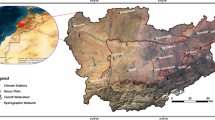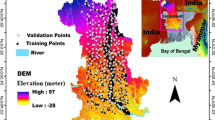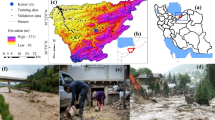Abstract
Floods are among the most severe natural hazard phenomena that affect people around the world. Due to this fact, the identification of zones highly susceptible to floods became a very important activity in the researcher’s work. In this context, the present research work aimed to propose the following 3 novel ensembles to estimate the flood susceptibility in Putna river basin from Romania: UltraBoost-Weights of Evidence (U-WOE), Stochastic Gradient Descending-Weights of Evidence (SGD-WOE) and Cost Sensitive Forest-Weights of Evidence (CSForest-WOE). In this regard, a sample of 132 flood locations and 14 flood predictors was used as input datasets in the 3 aforementioned models. The modeling procedure performed through a ten-fold cross-validation method revealed that the SGD-WOE ensemble model achieved the highest performance in terms of ROC Curve-AUC (0.953) and also in terms of Accuracy (0.94). The slope and distance from river flood predictors achieved the highest importance in terms of flood susceptibility genesis, while the aspect, TPI, hydrological soil groups, and plan curvature have the lowest influence in terms of flood occurrence. The area with high and very high susceptibility represents between 21% and 24% of the Putna river basin from Romania.






Similar content being viewed by others
Availability of Data and Materials
The data used in this research are available by the corresponding author upon reasonable request.
References
Afriyanie D, Julian MM, Riqqi A, Akbar R, Suroso DS, Kustiwan I (2020) Re-framing urban green spaces planning for flood protection through socio-ecological resilience in Bandung City. Indonesia Cities 101:102710
Allahbakhshian-Farsani P, Vafakhah M, Khosravi-Farsani H, Hertig E (2020) Regional flood frequency analysis through some machine learning models in semi-arid regions. Water Resour Manage 34:2887–2909
Arabameri A, Saha S, Chen W, Roy J, Pradhan B, Bui DT (2020) Flash flood susceptibility modelling using functional tree and hybrid ensemble techniques. Journal of Hydrology 587:125007 https://doi.org/10.1016/j.jhydrol.2020.125007
Armaş I (2012) Weights of evidence method for landslide susceptibility mapping. Prahova Subcarpathians Romania Natural Hazards 60:937–950
Arnell NW, Gosling SN (2016) The impacts of climate change on river flood risk at the global scale. Clim Change 134:387–401
Bui DT, Tsangaratos P, Ngo P-TT, Pham TD, Pham BT (2019) Flash flood susceptibility modeling using an optimized fuzzy rule based feature selection technique and tree based ensemble methods. Sci Total Environ 668:1038–1054
Bui Q-T, Nguyen Q-H, Nguyen XL, Pham VD, Nguyen HD, Pham V-M (2020) Verification of novel integrations of swarm intelligence algorithms into deep learning neural network for flood susceptibility mapping. J Hydrol 581:124379. https://doi.org/10.1016/j.jhydrol.2019.124379
Canbek G, Sagiroglu S, Temizel TT, Baykal N, Science, Engineering (2017) (UBMK), IEEE, pp. 821–826
Chakrabortty R, Pal SC, Janizadeh S, Santosh M, Roy P, Chowdhuri I, Saha A (2021) Impact of climate change on future flood susceptibility: an evaluation based on deep learning algorithms and GCM model. Water Resour Manage 35:4251–4274
Chao L, Zhang K, Wang J, Feng J, Zhang M (2021). A comprehensive evaluation of five evapotranspiration datasets based on ground and grace satellite observations: Implications for improvement of evapotranspiration retrieval algorithm. Remote Sens 13(12): 2414.
Chen Y, Xu Y, Yin Y (2009) Impacts of land use change scenarios on storm-runoff generation in Xitiaoxi basin, China. Quatern Int 208:121–128
Chen W, Li Y, Xue W, Shahabi H, Li S, Hong H, Wang X, Bian H, Zhang S, Pradhan B (2020) Modeling flood susceptibility using data-driven approaches of naïve bayes tree, alternating decision tree, and random forest methods. Sci Total Environ 701:134979
Chen X, Quan Q, Zhang K, Wei J (2021) Spatiotemporal characteristics and attribution of dry/wet conditions in the Weihe River Basin within a typical monsoon transition zone of East Asia over the recent 547 years. Environ Model Softw 143:105116.
Costache R, Bui DT (2019) Spatial prediction of flood potential using new ensembles of bivariate statistics and artificial intelligence: A case study at the Putna river catchment of Romania. Sci Total Environ 691:1098–1118
Costache R, Hong H, Wang Y (2019) Identification of torrential valleys using GIS and a novel hybrid integration of artificial intelligence, machine learning and bivariate statistics. CATENA 183:104179
Costache R, Pham QB, Arabameri A, Diaconu DC, Costache I, Crăciun A, Ciobotaru N, Pandey M, Arora A, Ali SA (2021) Flash-flood propagation susceptibility estimation using weights of evidence and their novel ensembles with multicriteria decision making and machine learning.Geocarto International1–33
Dahal RK, Hasegawa S, Nonomura A, Yamanaka M, Masuda T, Nishino K (2008) GIS-based weights-of-evidence modelling of rainfall-induced landslides in small catchments for landslide susceptibility mapping. Environ Geol 54:311–324
Dimeyeva L, Sitpayeva G, Sultanova B, Ussen K, Islamgulova A (2015) High-altitude flora and vegetation of Kazakhstan and climate change impacts. Climate Change Impacts on High-Altitude Ecosystems. Springer, pp 1–48
Dodangeh E, Choubin B, Eigdir AN, Nabipour N, Panahi M, Shamshirband S, Mosavi A (2020) Integrated machine learning methods with resampling algorithms for flood susceptibility prediction. Sci Total Environ 705:135983
Gao C, Hao M, Chen J, Gu C (2021) Simulation and design of joint distribution of rainfall and tide level in Wuchengxiyu Region, China. Urban clim. 40:101005.
Hoang N-D (2019) Automatic detection of asphalt pavement raveling using image texture based feature extraction and stochastic gradient descent logistic regression. Autom Constr 105:102843
Hong H, Panahi M, Shirzadi A, Ma T, Liu J, Zhu A-X, Chen W, Kougias I, Kazakis N (2018) Flood susceptibility assessment in Hengfeng area coupling adaptive neuro-fuzzy inference system with genetic algorithm and differential evolution. Sci Total Environ 621:1124–1141
Islam ARMT, Talukdar S, Mahato S, Kundu S, Eibek KU, Pham QB, Kuriqi A, Linh NTT (2021) Flood susceptibility modelling using advanced ensemble machine learning models. Geosci Front 12:101075
Jafari-Asl J, Seghier MEAB, Ohadi S, van Gelder P (2021) Efficient method using Whale Optimization Algorithm for reliability-based design optimization of labyrinth spillway. Appl Soft Comput 101:107036
Janizadeh S, Vafakhah M, Kapelan Z, Dinan NM (2021) Novel Bayesian additive regression tree methodology for flood susceptibility modeling. Water Resour Manage 35:4621–4646
Lee S, Kim J-C, Jung H-S, Lee MJ, Lee S (2017) Spatial prediction of flood susceptibility using random-forest and boosted-tree models in Seoul metropolitan city, Korea. Geomatics, Natural Hazards and Risk 8, 1185–1203
Li X, Li X, Wang Y, Hu Y, Zhou C, Zhang H (2022) Numerical Investigation on Stratum and Surface Deformation in Underground Phosphorite Mining Under Different Mining Methods. Front Earth Sci 10:831856. https://doi.org/10.3389/feart.2022.831856
Liu Y, Zhang K, Li Z, Liu Z, Wang J, Huang P (2020) A hybrid runoff generation modelling framework based on spatial combination of three runoff generation schemes for semi-humid and semi-arid watersheds. J Hydrol 590:125440.
Liu S, Liu Y, Wang C, Dang X (2022) The Distribution Characteristics and Human Health Risks of High- Fluorine Groundwater in Coastal Plain: A Case Study in Southern Laizhou Bay, China. Front Environ Sci 10:901637. https://doi.org/10.3389/fenvs.2022.901637.
Liuzzo L, Sammartano V, Freni G (2019) Comparison between different distributed methods for flood susceptibility mapping. Water Resour Manage 33:3155–3173
Liu Y, Zhang Z, Liu X, Wang L, Xia X (2021a) Efficient image segmentation based on deep learning for mineral image classification. Adv Powder Technol 32(10): 3885-3903.
Liu Y, Zhang Z, Liu X, Wang L, Xia X (2021b) Ore image classification based on small deep learning model: Evaluation and optimization of model depth, model structure and data size. Miner Eng 172:107020.
Mehta N, Devarakonda MV (2018) Machine learning, natural language programming, and electronic health records: The next step in the artificial intelligence journey? J Allergy Clin Immunol 141:2019–2021
Moustafa AF, Cary TW, Sultan LR, Schultz SM, Conant EF, Venkatesh SS, Sehgal CM (2020) Color doppler ultrasound improves machine learning diagnosis of breast cancer. Diagnostics 10:631
Nachappa TG, Piralilou ST, Gholamnia K, Ghorbanzadeh O, Rahmati O, Blaschke T (2020) Flood susceptibility mapping with machine learning, multi-criteria decision analysis and ensemble using Dempster Shafer Theory.Journal of Hydrology125275
Pistrika A, Tsakiris G, Nalbantis I (2014) Flood depth-damage functions for built environment. Environ Processes 1:553–572
Quan Q, Liang W, Yan D, Lei J (2022) Influences of joint action of natural and social factors on atmospheric process of hydrological cycle in Inner Mongolia, China. Urban clim. 41:101043.
Rad MJG, Ohadi S, Jafari-Asl J, Vatani A, Ahmadabadi SA, Correia JA (2022) GNDO-SVR: An efficient surrogate modeling approach for reliability-based design optimization of concrete dams. Presented at the Structures, pp 722–733
Romanescu G, Nistor I (2011) The effects of the July 2005 catastrophic inundations in the Siret River’s Lower Watershed, Romania. Nat Hazards 57:345–368
Siers MJ, Islam MZ (2015) Software defect prediction using a cost sensitive decision forest and voting, and a potential solution to the class imbalance problem. Inform Syst 51:62–71
Tehrany MS, Pradhan B, Jebur MN (2015) Flood susceptibility analysis and its verification using a novel ensemble support vector machine and frequency ratio method. Stoch Env Res Risk Assess 29:1149–1165
Tian J, Liu Y, Zheng W, Yin L (2021) Smog prediction based on the deep belief-BP neural network model (DBN-BP). Urban Clim. 41:101078
Tîrnovan A, Cojoc GM, Romanescu G, Obreja F (2014) Predicting the potential index of major floods production in the Suha river basin (Suha Bucovineana). Water resources and wetlands
Vojtek M, Vojteková J (2019) Flood susceptibility mapping on a national scale in Slovakia using the analytical hierarchy process. Water 11:364
Wang Y, Fang Z, Hong H, Peng L (2020) Flood susceptibility mapping using convolutional neural network frameworks. J Hydrol 582:124482
Wang S, Zhang K, Chao L, Li D, Tian X, Bao H, Chen G, Xia Y. (2021) Exploring the utility of radar and satellite-sensed precipitation and their dynamic bias correction for integrated prediction of flood and landslide hazards. J Hydrol 603: 126964.
Yin L, Wang L, Keim BD, Konsoer K, Zheng W (2022a) Wavelet Analysis of Dam Injection and Discharge in Three Gorges Dam and Reservoir with Precipitation and River Discharge. Water 14(4):567.
Zhan C, Dai Z, Soltanian MR, Zhang X (2022a) Stage?Wise Stochastic Deep Learning Inversion Framework for Subsurface Sedimentary Structure Identification. Geophys Res Lett 49(1):e2021GL095823. https://doi.org/10.1029/2021GL095823
Yin L, Wang L, Huang W, Tian J, Liu S, Yang B, Zheng W (2022b) Haze Grading Using the Convolutional Neural Networks. Atmosphere 13(4):522.
Xie W, Li X, Jian W, Yang Y, Liu H, Robledo LF, Nie W (2021a) A Novel Hybrid Method for Landslide Susceptibility Mapping-Based GeoDetector and Machine Learning Cluster: A Case of Xiaojin County, China. ISPRS Int J Geo-Inf 10(2):93.
Xie W, Nie W, Saffari P, Robledo LF, Descote P, Jian W (2021b) Landslide hazard assessment based on Bayesian optimization?support vector machine in Nanping City, China. Nat Hazards 109(1):931-948.
Zhan C, Dai Z, Samper J, Yin S, Ershadnia R, Zhang X, Wang Y, Yang Z, Luan X, Soltanian MR (2022b) An integrated inversion framework for heterogeneous aquifer structure identification with single-sample generative adversarial network. J Hydrol 610:127844.
Zhang K, Wang S, Bao H, Zhao X (2019) Characteristics and influencing factors of rainfall-induced landslide and debris flow hazards in Shaanxi Province, China. Nat Hazards Earth Syst Sci 19(1):93-105.
Zhang Z, Luo C, Zhao Z (2020) Application of probabilistic method in maximum tsunami height prediction considering stochastic seabed topography. Nat Hazards 104:2511-2530.
Zhang X, Ma F, Yin S, Wallace CD, Soltanian MR, Dai Z, Ritzi RW, Ma Z, Zhan C, L? X (2021) Application of upscaling methods for fluid flow and mass transport in multi-scale heterogeneous media: A critical review. Appl Energy, 303:117603.
Zhang K, Shalehy MH, Ezaz GT, Chakraborty A, Mohib KM, Liu L (2022). An integrated flood risk assessment approach based on coupled hydrological-hydraulic modeling and bottom-up hazard vulnerability analysis. Environ Model Softw 148:105279.
Zhao T, Shi J, Lv L, Xu H, Chen D, Cui Q, Jackson TJ, Yan G, Jia L, Chen L, Zhao K, Zheng X, Zhao L, Zheng C, Ji D, Xiong C, Wang T, Li R, Pan J, Wen J, Yu C, Zheng Y, Jiang L, Chai L, Lu H, Yao P, Ma J, Lv H, Wu J, Zhao W, Yang N, Guo P, Li Y, Hu L, Geng D, Zhang Z (2020). Soil moisture experiment in the Luan River supporting new satellite mission opportunities. Remote Sens Environ 240:111680.
Zhou G, Li C, Zhang D, Liu D, Zhou X, Zhan J (2021a) Overview of Underwater Transmission Characteristics of Oceanic LiDAR. IEEE J Sel Top Appl Earth Obs Remote Sens 14:8144-8159.
Zhou G, Long S, Xu J, Zhou X, Song B, Deng R, Wang C (2021b) Comparison Analysis of Five Waveform Decomposition Algorithms for the Airborne LiDAR Echo Signal. IEEE J Sel Top Appl Earth Obs Remote Sens 14:7869-7880.
Funding
This work was supported by a grant of the Romanian Ministry of Education and Research, CNCS – UEFISCDI, project number PN-III-P1-1.1-PD-2019-0424-P, within PNCDI III.
Author information
Authors and Affiliations
Contributions
Conceptualization, R.C., I.C., A.C. and B.T.P.; methodology, R.C., A.A. and I.C.; software, R.C., I.C., and B.T.P.; validation, R.C., I.C., A.C. and B.T.P.; formal analysis, R.C., A.A., A.C. and I.C.; investigation, R.C., A.A. and I.C.; resources, R.C., I.C. and B.T.P.; data curation, R.C., I.C. and B.T.P.; writing—original draft preparation, R.C., I.C. and B.T.P.; writing—review and editing, R.C., A.A. and I.C.; visualization, R.C. and B.T.P.; supervision, R.C., A.A. and I.C.; project administration, R.C.; funding acquisition, R.C. and B.T.P. All authors have read and agreed to the published version of the manuscript.
Corresponding author
Ethics declarations
Ethics Approval
The authors confirm that this article is original research and has not been published or presented previously in any journal or conference in any language (in whole or in part).
Consent to Participate and Consent to Publish
Not applicable.
Competing Interests
The authors have no conflict of interest.
Additional information
Publisher’s Note
Springer Nature remains neutral with regard to jurisdictional claims in published maps and institutional affiliations.
Electronic supplementary material
Below is the link to the electronic supplementary material.
Rights and permissions
Springer Nature or its licensor holds exclusive rights to this article under a publishing agreement with the author(s) or other rightsholder(s); author self-archiving of the accepted manuscript version of this article is solely governed by the terms of such publishing agreement and applicable law.
About this article
Cite this article
Costache, R., Arabameri, A., Costache, I. et al. New Machine Learning Ensemble for Flood Susceptibility Estimation. Water Resour Manage 36, 4765–4783 (2022). https://doi.org/10.1007/s11269-022-03276-0
Received:
Accepted:
Published:
Issue Date:
DOI: https://doi.org/10.1007/s11269-022-03276-0




